 Charles William Millington in 1970 (Congleton, Cheshire, UK,
1914 - Prestwich, Lancashire,
UK, 1988)
Charles William Millington in 1970 (Congleton, Cheshire, UK,
1914 - Prestwich, Lancashire,
UK, 1988)(even fuzzy... thanks to Bernard Lemaire who provided me this photo!)
Morpion Solitaire - First Record Grids (5T game)
|
Thanks to Pierre Berloquin who allowed
me to access his archives. I was happy to find the handwritten grids, as
sent by the
readers of Science & Vie in 1974-1976. |
 Charles William Millington in 1970 (Congleton, Cheshire, UK,
1914 - Prestwich, Lancashire,
UK, 1988)
Charles William Millington in 1970 (Congleton, Cheshire, UK,
1914 - Prestwich, Lancashire,
UK, 1988)
(even fuzzy... thanks to Bernard Lemaire
who provided me this photo!)
149. The first record announced by Pierre Berloquin in his first column of 1974 on Morpion Solitaire was a grid of 149 moves constructed by C. W. Millington in 1972. This grid had been sent by Bernard Lemaire, professor at the CNAM Paris (Conservatoire National des Arts et Métiers): Millington is his father-in-law!
Charles W. Millington, a native of Cheshire (a county in northwestern England), served in World War II, particularly in the evacuation of Dunkirk in 1940, then in the Allied invasion of June 6, 1944 ("D-Day"), in the liberation of France, going as far as Hamburg in Germany. He worked in several fields: as a farmer, a cook, a fireman, a decorator, etc... Although he was not able to go to university, he was gifted with remarkable powers of observation and logical deduction. He was a formidable card player: rummy, whist, and, above all, bridge. He was also extremely interested in mathematical puzzles, often from Dudeney, and so in Morpion Solitaire. He was living then in Manchester. Here is his grid as published in Science & Vie:
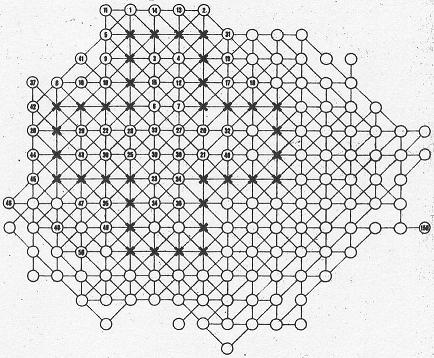
1972: First known record, with this grid of 149 moves by C. W.
Millington
(incorrectly announced of 150 moves by Science & Vie)
Bernard Lemaire, searching in his archives, found original grids handwritten by his father-in-law. The first grid below on the left was probably one of his first good results before his record: C.W. Millington obtains "only" 132 moves, but it is already an excellent score when we start playing at this game. We can read in the left bottom his words "Bernard. I hope you can follow this. Your apology for the cheating bit will be accepted, I think! Dad". The second one is the ORIGINAL grid of the first record published in Science & Vie, a historical bit of paper! The bad count of 149/150 moves was already in his own grid.
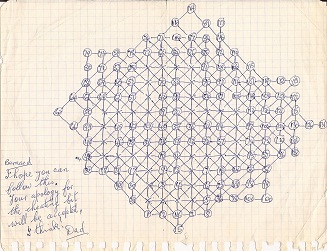

Handwritten
grids of C. W. Millington sent to Bernard Lemaire. 132 moves, and 149/150 moves
152. After his grid of 149 moves, C. W. Millington was the first to beat his own record with 152 moves in 1974, before J.-C. Geay of Roanne (student in Mathématiques Spéciales St Etienne), Jean Palesi of Lille (mathematics teacher, ENSAM Lille), and Marc Chollou of Vaucresson. The first name Marc was not written in the letter, but I was able to locate this author in February 2010. These 4 grids of 152 moves were not published in Science & Vie, only scores and names were given. We can see that these grids are the same (except move numbers), they are a direct improvement of the end of Millington's first grid of 149 moves:

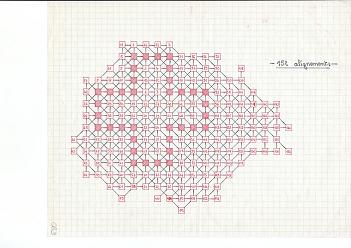
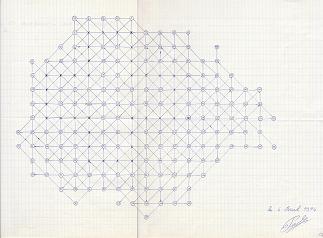
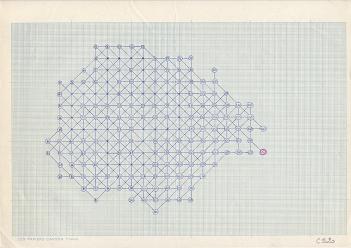
1974: The first four grids of 152 moves, top by C. W. Millington and J.-C.
Geay, bottom by J. Palesi and M. Chollou.
162, 163. A grid of 162 moves constructed by Rémy Daubié, Epinal, was published in November 1974. See Science & Vie article. Compared to the previous record, this is a big improvement of 10 moves! This time the grid was new, not directly reusing the beginning of Millington's grid of 149 moves. In July 1975 a new record of 163 moves was announced, again by C. W. Millington, but this grid had not been published: we can see that Millington improved the end of Daubié's grid:
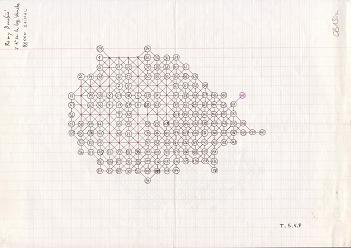
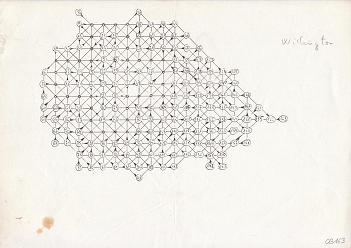
1974-1975: Grid of 162 moves by R. Daubié, and grid of 163 moves by C. W.
Millington
164. A grid of 164 moves constructed by Joseph Martin, Paris, greatly inspired by the Daubié's grid, was published in November 1975. Two other people had also done 3 other grids of 164 moves, but not published in Science & Vie: two grids by Yoland Strehl of Eaubonne, and one grid by Michel Szeps of La Ferté Imbault. We can see that Strehl's second grid and Szeps' grid are the same:

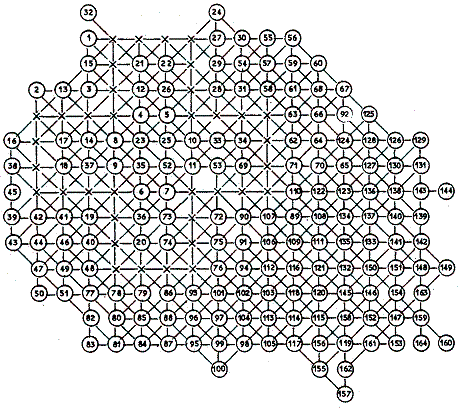
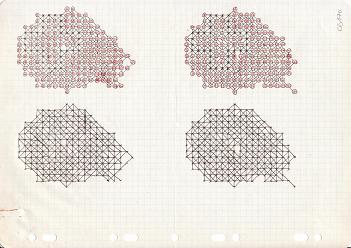
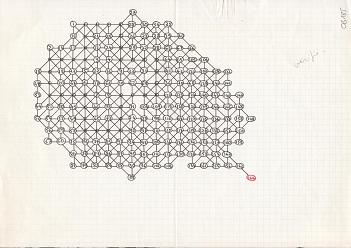
1975: Grids of 164 moves by J. Martin (top left his original
grid, top right as published in Science & Vie),
and bottom by Y.
Strehl and M. Szeps.
170. In 1976, an impressive record of 170 moves was done by Charles-Henri Bruneau. It has been the world record up to 2010!
Other grids received by Science & Vie in 1974
Here are some other interesting grids from 151 to 157 moves received in 1974 by Pierre Berloquin for his column in Science & Vie. These grids are better than the first published Millington's record, but never mentioned in his column because they were beaten by the above grids.

Grids improved by Zbigniew Galias
In February-March 2010, Zbigniew Galias, Poland, tried to improve the final moves of the old grids given in this page. He succeeded to add from 1 to 4 supplemental moves on several grids, his best result being this one:
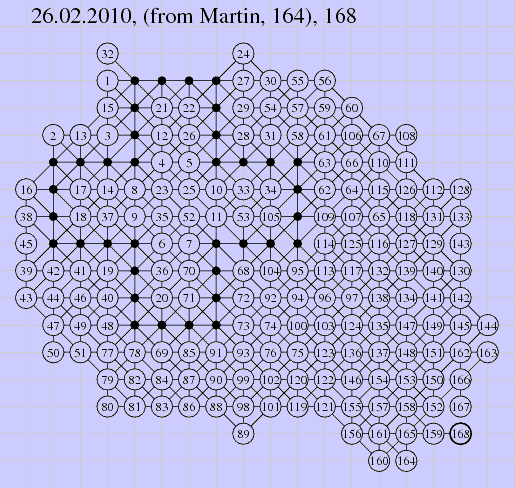
February
2010: Grid of 168 moves by Zbigniew Galias,
improving by 4 moves Joseph Martin's
grid of 164 moves
Here are his main results, click on the new score to display the new improved grid:
|
Original grid |
Improved grid by Z. Galias |
|||
|
Author |
Score |
Improvement |
New score |
Number of final moves found to be optimal |
|
Martin |
164 |
+ 4 |
103 |
|
|
Szeps |
164 |
+ 3 |
87 |
|
|
Strehl |
164 |
0 |
164 unchanged |
79 |
|
Bigot |
157 |
+ 1 |
? |
|
|
Ribaud |
154 |
+ 3 |
95 |
|
|
Goffinet |
152 |
+ 4 |
68 |
|
|
Prangé |
151 |
+ 4 |
84 |
|
|
Millington |
152 |
+ 2 |
70 |
|
|
Bodin-Hullin |
152 |
+ 1 |
? |
|
|
Petit |
153 |
0 |
153 unchanged |
67 |
© Christian Boyer, www.morpionsolitaire.com